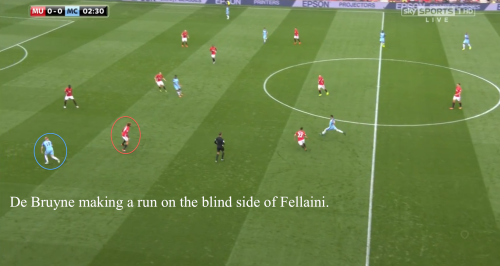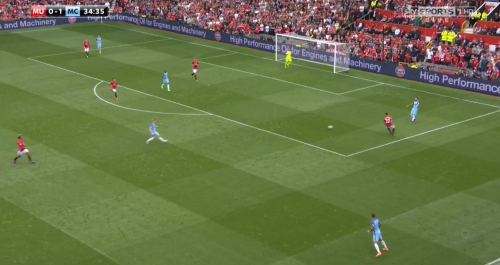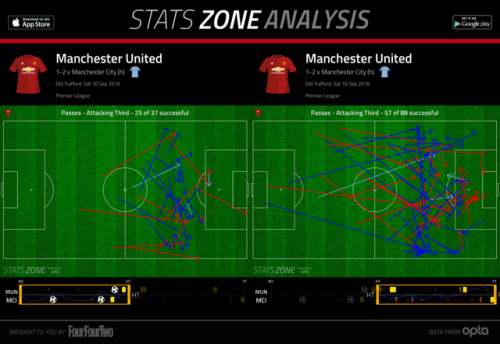Match date: 10 September 2016
Plenty of storylines coming into this match: obviously the Manchester derby, Mourinho and Guardiola’s friendship-turn-rivalry, the respective managers’ style of play, and the amount of money spent to put together teams of such quality.
Mourinho set his side out in a 4-2-3-1 with Mkhitaryan and Lingard both given their first Premier League starts of the season. Pogba and Fellaini continued in a double pivot with Rooney in front of them supporting Ibrahimovic.
Guardiola gave Claudio Bravo his debut after moving from Barcelona, while Iheanacho started at centre forward with the absence of Sergio Agüero. Guardiola’s side looked like a 4-3-3, with De Bruyne given a lot of freedom.

De Bruyne’s Significant Influence
A game against different ideas where one team likes to control the ball and the other likes to control the space, it was in midfield where this ‘battle’ became very evident, particularly in the first half, and the victor was Manchester City. As mentioned above, Manchester United continued in a 4-2-3-1 with Pogba and Fellaini the two midfielders, with Rooney in front of them providing support to Ibrahimovic. Manchester City were in a 4-3-3 with Silva and De Bruyne in front of Fernandinho. Both Silva and De Bruyne have not really played as central midfielders in a 4-3-3 previously. Under Pellegrini, they were both used either out wide in Pellegrini’s 4-4-2/4-2-2-2 variation or as something of a number 10 in a 4-2-3-1. Thus far, however, the two have looked good in central midfield roles under Guardiola and De Bruyne, in particular, looked very good against Manchester United.
Prior to the match, Jose Mourinho said that Manchester United were going to find it harder without Agüero being available for Manchester City and it appears that Mourinho was right as he miscalculated how big of an influence De Bruyne would have in the absence of Agüero. Where the central triangles of the Manchester sides matched up on paper, it seemed that Mourinho had no plan to really adapt to De Bruyne and Silva’s movement around Pogba and Fellaini. Countless times, De Bruyne drifted to the left side of Manchester City’s attack. One of the first good chances for either team came after De Bruyne peeled away from Fellaini, in between Valencia and Bailly, and the Belgian’s consistent movement, without a consistent mark, allowed him to control the game for Manchester City in the opening half.

Despite the directness of Manchester City’s opening goal, scored by De Bruyne, it highlighted again that neither Pogba or Fellaini took responsibility or had the tactical discipline to consistent mark De Bruyne. However, there were more issues for Manchester United than the failings of Pogba and Fellaini; Pep had Nolito and Sterling stretch the game as wide as they could, meaning that both Shaw and Valencia were forced to take up wider positions which left the Manchester United back four incredibly stretched. De Bruyne’s runs into the left half space were the result of Nolito dragging Valencia out wide and the game created between the United right back and Bailly. It was a move calculated by Guardiola and it certainly got the better of Mourinho and his side.

Not only did De Bruyne score the opening goal and tear Pogba and Fellaini apart with his movement in the first half, not to mention nearly scoring a second in the opening 45 minutes that Iheanacho tapped in, but in the second half, as a false nine, he nearly had again after good movement into the penalty area.
Differences in Pressing
Going into the match, there were a few questions to address: is Mourinho going to have his side try to press high when City try to build out of the back? What are Manchester City’s fullbacks going to do? The answer to these questions are that Manchester United did try to press and that the Manchester City full backs mostly stayed in more conventional wide positions.
The issue with Manchester United’s pressing was fairly simple in that they did not commit enough numbers to press. When Bravo had the ball had his feet, he always had an option, even he had to delay his pass, he knew the movement of his teammates would open create an easy option.
Below is a good example of City’s ability to quickly play out. Stones plays the ball back to Bravo, Bravo plays it over to Otamendi, De Bruyne shows for the ball and then plays a quick pass out to Kolarov. This situation was in a theoretically advantageous situation for Manchester United as Sagna played a sloppy back pass to Stones, leading the centre back just about to the end line before he could play to Bravo. This should have allowed for Manchester United to commit numbers forward, but as you can see below, there was a huge gap between the lines for Manchester United. The initial press is fine, but once the first line of pressure was beaten, Manchester City were easily able to get forward with their attacks.

There was times when Stones moved into a central midfield area when the ball was out wide, seeing Fernandinho drop deeper to get away from Rooney during build up. A lot of the time in the first half, Stones and Otamendi were able to carry the ball forward in their half space without pressure from Manchester United. Mkhitaryan and Lingard were dragged away from the centre of the pitch by Kolarov and Sagna, Rooney followed Fernandinho, and Fellaini and Pogba were trying to deal with Silva and De Bruyne. That first good chance that came from De Bruyne’s movement behind Fellaini and between Valencia and Bailly came after Otamendi was allowed to travel with the ball and then play an excellent through ball for De Bruyne.
Whereas Manchester United’s pressing was disorganised, Manchester City’s was energetic, which does not necessarily mean it was well organised (although it was relatively), but it was effective. The midfield battle of Pogba and Fellaini against Fernandinho, De Bruyne, and Silva allowed Manchester City to win the ball back quickly and high up the pitch through numbers and intensity around the ball. Silva, in particular, darted around the middle third of the field to win the ball back for his side, something that he would not have done under Pellegrini in the last few years.

Structurally, Manchester City did not look as prepared for Manchester United’s counter attacks and United did look dangerous a few times when Pogba was able to strove forward with the ball. Once someone like Pogba was able to resist the initial City press, they were able to get numbers forward. Though it is hard to remember an instance when Manchester United were able to get a quality shot on target from one of their counter attacks in the first half. There were a handful of United counter attacks, which Guardiola knows, but City’s initial press through Silva, De Bruyne, and Fernandinho was typically very good.
Mourinho’s Changes, Pep Responds
The Manchester United boss had to make changes at half time and he could have done so for a number of players, but chose Lingard (who had a placard behind him at times saying ‘Boy to FA Cup Hero’) and Mkhitaryan to take off for Herrera and Rashford. This changed Manchester United from a 4-2-3-1 to a 4-3-3 with Rashford on the left and Rooney on the right, while Herrera played in a holding midfield role behind a now more advanced Pogba and Fellaini.

The impact of the changes was immediate as now United had pace on the left through Rashford, had more stability in the middle of the pitch with Herrera doing a very good job, and the ability to play more direct with Pogba and Fellaini more advanced positions. Manchester United were now able to get the ball forward much quicker and assert more pressure on Manchester City and more control on the game The passing diagram below really shows the difference in play.

It also allowed for their pressing to be much more effective as Bravo now had to go long much more often and was really put under pressure with the ball at his feet (think just before his incident with Rooney in the penalty area).
With Mourinho’s changes, Guardiola reacted quickly. After just eight minutes into the second half, he took off Iheanacho, who had done relatively well, for Fernando. This move meant that De Bruyne moved forward into a ‘false nine’ position, while Fernandinho moved forward in middle next to Silva, maintaining City’s 4-3-3, but giving them another ball winner in midfield. At this point, United were getting numbers forward, but were incredibly vulnerable to City’s counter attacks and the visitors should have done better with their chances in the second half. De Bruyne was incredibly unlucky not to have another goal after a City counter attack, with his shot going off the inside of the near post and moving across the line before going out for a goal kick near the far post.
With his side down 2-1, Mourinho made his last change, bringing on Martial for Shaw, essentially giving Manchester United a front four of Martial, Rashford, Ibrahimovic, and Rooney. Pep adjusted his side to a 5-4-1 with Fernando dropping between Stones and Otamendi to maintain City’s numerical advantage at the back.
Conclusion
Guardiola wins another contest between Mourinho, giving him a significant advantage between the two. With arguably the best managers in the world on show in the Premier League this season, we were given a really good look at what that means: a high energy league, with tactical greatness. Guardiola’s plan bettered Mourinho’s in the first half and it was the best showings of football in the Premier League so far this season.
After the match, Mourinho bemoaned the decision not to award a penalty on Bravo’s challenge on Rooney and wanted a handball against Otamendi, while Guardiola said that his side need to improve significantly if they want to win the league, let alone, the Champions League.
Peter Motzenbecker
Latest posts by Peter Motzenbecker (see all)
- Liverpool vs Manchester City: Tactical Analysis - January 17, 2018
- The Manchester Derby: Post-Match Tactical Analysis - September 13, 2016
- Arsenal vs Liverpool: The Tactical View - August 17, 2016
